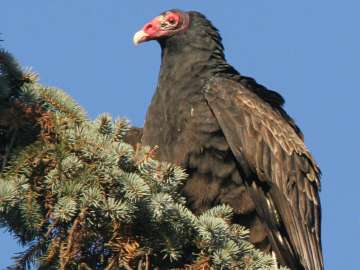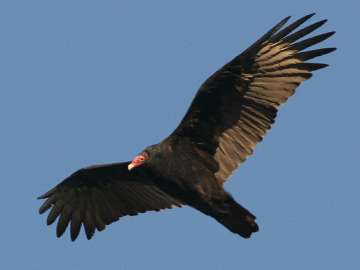Nature Notes

PHOTO COURTESY OF GARRY KESSLER
The adult black vulture’s head is bare and all black.
April 20, 2024
NATURE NOTES
By Annie Reid
Westborough Community Land Trust
Black vultures are newcomers to our region
Increasingly, black vultures (Coragyps atratus) are newcomers to our region. They’re expanding their range northward and joining our local scavengers – our clean-up crew. Turkey vultures, raccoons, skunks, opossums, coyotes, crows, ravens, mice, even bald eagles, and of course insects, are much underappreciated for cleaning up our natural environment and preventing disease. How? By removing the dead. They are active and efficient as they feed on already-dead meat, otherwise known as carrion.
Black vultures can pick a carcass clean with their sharp, hooked beaks, but they can’t tear open a fresh carcass to begin feeding. Others scavengers do that. And they can’t carry away dead prey with their feet, which have toes more suited for walking.
Amazingly, black vultures, like turkey vultures and other vultures, eat rotten meat without getting sick themselves or spreading disease. How do they do it? For one thing, the strong acids and harsh conditions in their stomachs degrade many microbes. The result is a much greater diversity of microbes on vultures’ faces than in their digestive systems. For another thing, vultures have evolved a tolerance for toxins made by microbes in decaying meat. These substances may help vultures digest their carrion meals. Researchers recently found that the dominant microbes in vultures’ digestive systems are ones that cause disease in many other animals (Clostridia and Fusobacteria).

PHOTO COURTESY OF GARRY KESSLER
Black vulture in flight, with white wingtips visible.
Would you like to see a black vulture? Your best bet is to keep your eyes to the sky to spot one soaring overhead. Black vultures look all dark in the sky, except for white wingtips. You can often see the white wingtips with your naked eye, although binoculars help.

PHOTO COURTESY OF GARRY KESSLER
The adult turkey vulture’s bare head is red.
Turkey vultures (Cathartes aura) are the other, more common vultures around here (https://westboroughlandtrust.org/nn/nn153). Looking up at turkey vultures, you might notice white or silvery-gray underneath their outspread wings.
As you watch the sky for large birds, you might occasionally recognize an adult bald eagle by its white head and white tail.
Notice that the two vultures fly differently. Black vultures hold their wings out flat and straight, plank-like. They’ll flap their wings several times and then glide for a while. Watch for this “flap-flap-flap-glide” pattern.

PHOTO COURTESY OF GARRY KESSLER
Turkey vulture in flight, showing white or silvery-gray underneath its wings.
In contrast, turkey vultures hold their wings in a shallow “V” shape – not flat – as they fly low and slowly over treetops. Their flight looks wobbly, almost tipsy.
Both black vultures and turkey vultures rely on rising air currents to become airborne and to fly, but their different flight styles help them forage for food. Black vultures fly high and depend on their keen eyesight to spot a carcass – small or large – far below on the ground. They evolved this style over thousands of years of living in open environments.
Turkey vultures, on the other hand, also have keen eyesight but rely instead on their sense of smell. Black vultures and almost all birds lack a keen sense of smell. The turkey vultures’ low flight with side-to-side wobbling helps them to sample the air for a whiff of carrion. By following the scent of rotting meat – especially the chemical ethyl mercaptan – turkey vultures find carcasses that are out of sight in forests or even hidden under leaves or some dirt. Smell helped them survive as they evolved in forest environments.

PHOTO COURTESY OF Eileen Sawyer
Distant adult bald eagle in flight, with white head and tail.
You’d think that turkey vultures’ sense of smell would give them a winning advantage over black vultures, but no. Black vultures are smart. While looking for food, they also watch turkey vultures and follow them to their finds.
Seen up close, both vultures have bare heads without feathers – easy to clean after messy eating. Black vultures have black heads, while turkey vultures have red heads. Both are big (4-5 lbs, 4-6 ft wingspan), but black vultures are a bit smaller than turkey vultures.
Where can you get a close view of black vultures, or for that matter, turkey vultures? Both kinds roost in tall trees or on communication towers, sometimes in surprising numbers. They rest, hang out near family members, and gather information (such as clues to nearby food) at roosting sites.
You might also spot them at road kills or garbage dumps.
Black vultures come to us from the southeastern U.S., much as turkey vultures did. (Turkey vultures are now considered “permanent residents” here.) Black vultures are moving northward as our now-familiar cardinals, tufted titmice, Carolina wrens, red-bellied woodpeckers, and mockingbirds have done.
First documented in Massachusetts in 1850, black vultures were still considered “rare visitors” in 1993. A nesting pair was first recorded in our state in 1998. The Forbush Bird Club recently described Worcester County’s black vultures as a “migrant, possible breeder, reported every month” (Chickadee, Forbush Bird Club, 2022).
Check out a recent article in Massachusetts Wildlife magazine (No. 4, 2021) that describes biologists tagging and tracking a black vulture chick from a cliff nest in Russell, MA (https://westboroughlandtrust.org/cal/extras/masswildlife_2021-04_black-vulture.pdf). They nick-named the chick Tekoa, after Mount Tekoa there.
As you walk trails through fields and woods this spring, think about why dead creatures are a rare sight in the wild – and be grateful for nature’s scavengers.